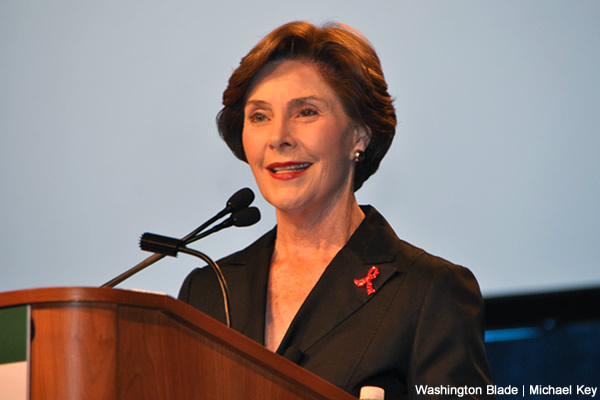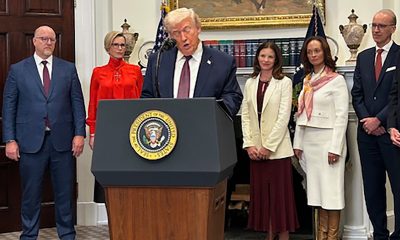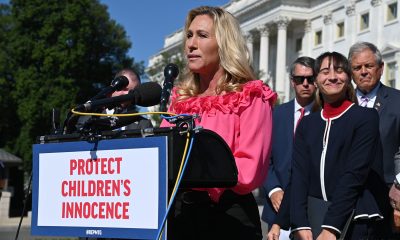National
AIDS 2012: Laura Bush stresses women pivotal in fight against AIDS
Former First Lady and Aung San Suu Kyi address International AIDS Conference
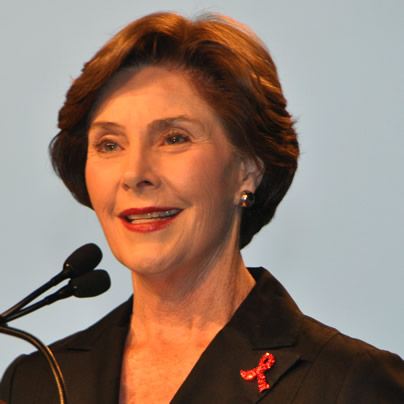
Former First Lady Laura Bush stressed on Thursday that women continue to play a crucial role in the global fight against HIV/AIDS.
“When you look around the world, you see that women are in the forefront of life changing progress,” she said during her speech at the International AIDS Conference at the Walter E. Washington Convention Center. “Women have been central in the fight against AIDS.”
Bush cited a woman with HIV whom she met with her husband, former President George W. Bush, in Africa last December that had been shunned by her family after her husband passed away. A faith-based organization subsequently taught her how to make purses from recycle materials. And she now supports her children and the family that had once ostracized her. “Her story is a powerful testament to why we must do more to promote the good health of women everywhere,” said the former First Lady. “The health of women affects families, communities and whole countries. Healthy mothers make healthy families.”
Bush also referenced her mother-in-law, former First Lady Barbara Bush, as someone who helped change attitudes about HIV in this country. She noted that the former First Lady held babies and hugged people with AIDS and met with families of those who had lost loved ones to the epidemic at a time when stigma against those with the virus was rampant. Barbara Bush also visited the AIDS Memorial Quilt on the National Mall.
“Her graceful example challenged all Americans to confront HIV/AIDS with care and compassion, rather than fear and judgment,” said Laura Bush.
She further categorized the President’s Emergency Plan for AIDS Relief that her husband announced during his 2003 State of the Union address as a blueprint to fight other global epidemics. PEPFAR committed $15 billion over five years to fund HIV prevention efforts, anti-retroviral drugs for those living with the virus and programs for children orphaned by AIDS.
Laura Bush stressed that both she and her husband have seen “first-hand the devastating toll of AIDS” during several trips they made to Africa during and after his presidency. She further recalled a young girl wearing a lavender dress that she and her daughter Barbara met at a Botswanan pediatric clinic a few months after the then-president announced PEPFAR.
“This precious little child lay on an examining table so frail and sick; her mother’s last hope was to make her beautiful,” said Laura Bush, who visited the same facility three weeks ago. “Today with access to anti-retrovirals, that little girl would have another chance at life.”
Statistics continue to show that women and girls remain disproportionately impacted by HIV/AIDS.
UNAIDS noted that 1.3 million women and girls became HIV-positive last year. The agency further reported that 63 percent of those between 15-24 living with the virus are young women — and 60 percent of those with HIV in sub-Saharan Africa are women and girls.
Laura Bush noted that rates of cervical cancer are nearly five times higher among women with HIV. The George W. Bush Institute, PEPFAR, Susan G. Komen for the Cure and UNAIDS last September pledged at least $75 million over five years to fight cervical and breast cancer among those with the virus through the “Pink Ribbon, Red Ribbon” initiative that Zambian First Lady Christine Kaseba and other female African leaders have endorsed. The former First Lady said more than 14,000 Zambian women have received these screenings – and nearly 40 percent of them live with HIV. Nearly a third of them tested positive for pre-cancerous or cancerous cervical cells. Of those, more than 80 percent were able to receive immediate treatment.
“In our fight against AIDS, we’ve learned that any measure of success requires sustained leadership at every level,” said Laura Bush. “By working together, we can give hope to mothers and fathers, to sisters and brothers, to wives and husbands and sons and daughters so they and their families can live full and productive lives.”
Burmese opposition leader Aung San Suu Kyi also spoke about the need to end stigma against those with HIV.
“Our people need to understand what HIV really is. We need to understand that this is not something that we need to be afraid of, that people who have contracted HIV need not to be discriminated against, that they’re not a danger to society at large,” she told AIDS 2012 delegates in a videotaped message. “Once this message has gotten through, we will be able to base activities on the natural compassion of human beings and of course as the great majority of people in Burma are Buddhist, there’s a special emphasis on the value of compassion. Based on this and based on wide community education, I hope that we will be able to become one of those innovative societies where we approach a problem as human beings — as intelligent, caring human beings. In this way, we will be able to handle not just the issue of AIDS and new ideas, but issues related to those who are subjected to particular suffering and particular discrimination.”
CARE President Dr. Helene Gayle noted that Suu Kyi, who won a seat in the Burmese Parliament in April, delivered a video address at the 2000 International AIDS Conference in South Africa. The Nobel Peace Prize recipient, who remained under house arrest for the better part of two decades until late 2010, held her first public event after the country’s rulers released her at an HIV/AIDS center.
“This was a powerful message to her people and to those living with HIV that their champion was again free and was going to work hard to improve their situation,” said Gayle. “She is a global icon for democracy and human rights and she is also in her dignified and quiet way a powerful AIDS advocate.”
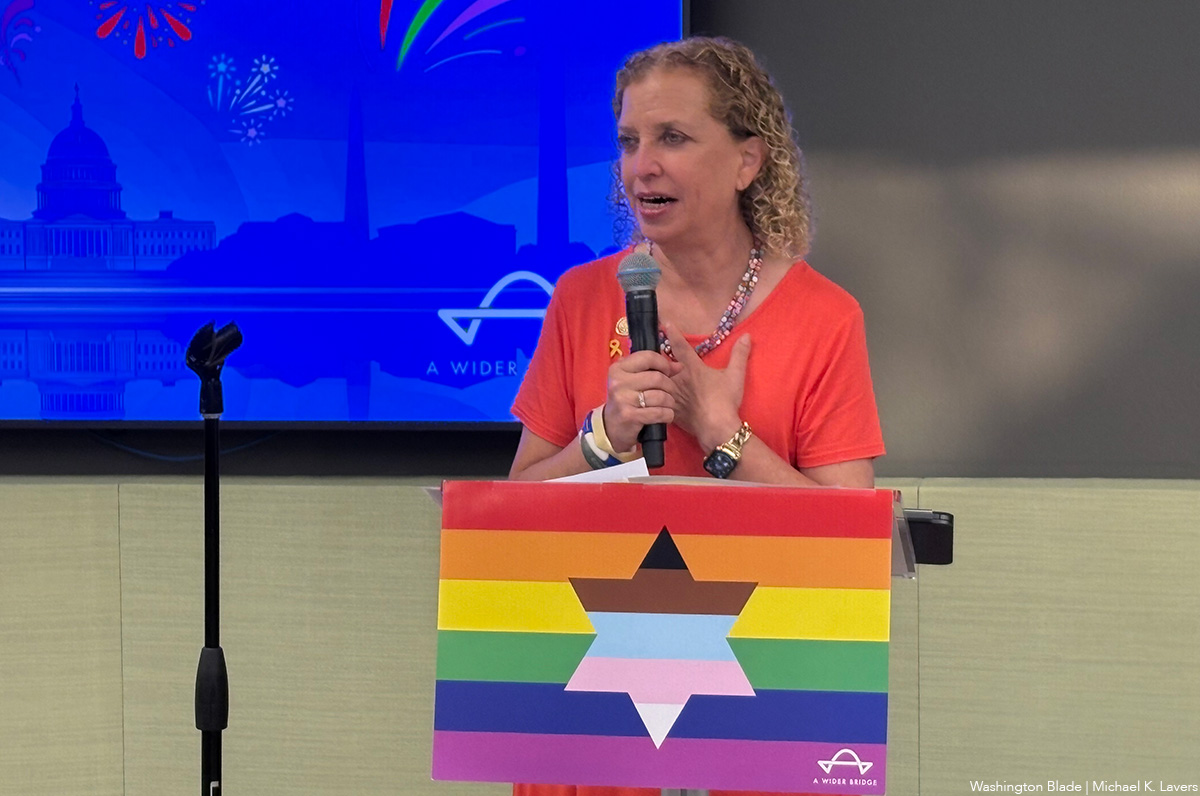
A Wider Bridge on Friday announced it will shut down at the end of the month.
The group that “mobilizes the LGBTQ community to fight antisemitism and support Israel and its LGBTQ community” in a letter to supporters said financial challenges prompted the decision.
“After 15 years of building bridges between LGBTQ communities in North America and Israel, A Wider Bridge has made the difficult decision to wind down operations as of Dec. 31, 2025,” it reads.
“This decision comes after challenging financial realities despite our best efforts to secure sustainable funding. We deeply appreciate our supporters and partners who made this work possible.”
Arthur Slepian founded A Wider Bridge in 2010.
The organization in 2016 organized a reception at the National LGBTQ Task Force’s Creating Change Conference in Chicago that was to have featured to Israeli activists. More than 200 people who protested against A Wider Bridge forced the event’s cancellation.
A Wider Bridge in 2024 urged the Capital Pride Alliance and other Pride organizers to ensure Jewish people can safely participate in their events in response to an increase in antisemitic attacks after Hamas militants attacked Israel on Oct. 7, 2023.
The Jewish Telegraphic Agency reported authorities in Vermont late last year charged Ethan Felson, who was A Wider Bridge’s then-executive director, with lewd and lascivious conduct after alleged sexual misconduct against a museum employee. Rabbi Denise Eger succeeded Felson as A Wider Bridge’s interim executive director.
A Wider Bridge in June honored U.S. Rep. Debbie Wasserman Schultz (D-Fla.) at its Pride event that took place at the Capital Jewish Museum in D.C. The event took place 15 days after a gunman killed two Israeli Embassy employees — Yaron Lischinsky and Sarah Milgrim — as they were leaving an event at the museum.
“Though we are winding down, this is not a time to back down. We recognize the deep importance of our mission and work amid attacks on Jewish people and LGBTQ people – and LGBTQ Jews at the intersection,” said A Wider Bridge in its letter. “Our board members remain committed to showing up in their individual capacities to represent queer Jews across diverse spaces — and we know our partners and supporters will continue to do the same.”
Editor’s note: Washington Blade International News Editor Michael K. Lavers traveled to Israel and Palestine with A Wider Bridge in 2016.
The White House
‘Trump Rx’ plan includes sharp cuts to HIV drug prices
President made announcement on Friday

President Donald Trump met with leaders from some of the world’s largest pharmaceutical companies at the White House on Friday to announce his new “Trump Rx” plan and outline efforts to reduce medication costs for Americans.
During the roughly 47-minute meeting in the Roosevelt Room, Trump detailed his administration’s efforts to cut prescription drug prices and make medications more affordable for U.S. patients.
“Starting next year, American drug prices will come down fast, furious, and will soon be among the lowest in the developed world,” Trump said during the meeting. “For decades, Americans have been forced to pay the highest prices in the world for prescription drugs by far … We will get the lowest price of anyone in the world.”
Trump signed an executive order in May directing his administration “to do everything in its power to slash prescription drug prices for Americans while getting other countries to pay more.”
“This represents the greatest victory for patient affordability in the history of American health care, by far, and every single American will benefit,” he added.
Several pharmaceutical executives stood behind the president during the announcement, including Sanofi CEO Paul Hudson, Novartis CEO Vas Narasimhan, Genentech CEO Ashley Magargee, Boehringer Ingelheim (USA) CEO Jean-Michel Boers, Gilead Sciences CEO Dan O’Day, Bristol Myers Squibb General Counsel Cari Gallman, GSK CEO Emma Walmsley, Merck CEO Robert Davis, and Amgen Executive Vice President Peter Griffith.
Also in attendance were Health and Human Services Secretary Robert F. Kennedy Jr., Commerce Secretary Howard Lutnick, Centers for Medicare and Medicaid Services Administrator Mehmet Oz, and Food and Drug Administration Commissioner Marty Makary.
Under the Trump Rx plan, the administration outlined a series of proposed drug price changes across multiple companies and therapeutic areas. Among them were reductions for Amgen’s cholesterol-lowering drug repatha from $573 to $239; Bristol Myers Squibb’s HIV medication reyataz from $1,449 to $217; Boehringer Ingelheim’s type 2 diabetes medication jentadueto from $525 to $55; Genentech’s flu medication xofluza from $168 to $50; and Gilead Sciences’ hepatitis C medication epclusa from $24,920 to $2,425.
Additional reductions included several GSK inhalers — such as the asthma inhaler advair diskus 500/50, from $265 to $89 — Merck’s diabetes medication januvia from $330 to $100, Novartis’ multiple sclerosis medication mayzent from $9,987 to $1,137, and Sanofi’s blood thinner plavix from $756 to $16. Sanofi insulin products would also be capped at $35 per month’s supply.
These prices, however, would only be available to patients who purchase medications directly through TrumpRx. According to the program’s website, TrumpRx “connects patients directly with the best prices, increasing transparency, and cutting out costly third-party markups.”
Kennedy spoke after Trump, thanking the president for efforts to lower pharmaceutical costs in the U.S., where evidence has shown that drug prices — including both brand-name and generic medications — are nearly 2.78 times higher than prices in comparable countries. According to the Pharmaceutical Research and Manufacturers of America, roughly half of every dollar spent on brand-name drugs goes to entities that play no role in their research, development, or manufacturing.
“This is affordability in action,” Kennedy said. “We are reversing that trend and making sure that Americans can afford to get the life-saving solutions.”
Gilead CEO Dan O’Day also spoke about how the restructuring of drug costs under TrumpRx, combined with emerging technologies, could help reduce HIV transmission — a virus that, if untreated, can progress to AIDS. The LGBTQ community remains disproportionately affected by HIV.
“Thank you, Mr. President — you and the administration,” O’Day said. “I think this objective of achieving the commitment to affordability and future innovation is extraordinary … We just recently launched a new medicine that’s only given twice a year to prevent HIV, and we’re working with Secretary Kennedy and his entire team, as well as the State Department, as a part of your strategy to support ending the epidemic during your term.
“I’ve never been more optimistic about the innovation that exists across these companies and the impact this could have on America’s health and economy,” he added.
Trump interjected, asking, “And that’s working well with HIV?”
“Yes,” O’Day replied.
“It’s a big event,” Trump said.
“It literally prevents HIV almost 100 percent given twice a year,” O’Day responded.
A similar anti-HIV medication is currently prescribed more than injectable form mentioned by O’Day. PrEP, is a medication regimen proven to significantly reduce HIV infection rates for people at high risk. Without insurance, brand-name Truvada can cost roughly $2,000 per month, while a generic version costs about $60 per month.
Even when medication prices are reduced, PrEP access carries additional costs, including clinic and laboratory fees, office visits, required HIV and sexually transmitted infection testing, adherence services and counseling, and outreach to potentially eligible patients and providers.
According to a 2022 study, the annual total cost per person for PrEP — including medication and required clinical and laboratory monitoring — is approximately $12,000 to $13,000 per year.
The TrumpRx federal platform website is now live at TrumpRx.gov, but the program is not slated to begin offering reduced drug prices until January.
The White House
EXCLUSIVE: Democracy Forward files FOIA lawsuit after HHS deadnames Rachel Levine
Trans former assistant health secretary’s name changed on official portrait

Democracy Forward, a national legal organization that works to advance democracy and social progress through litigation, policy and public education, and regulatory engagement, filed a lawsuit Friday in federal court seeking to compel the U.S. Department of Health and Human Services to release information related to the alteration of former Assistant Secretary for Health Adm. Rachel Levine’s official portrait caption.
The lawsuit comes in response to the slow pace of HHS’s handling of multiple Freedom of Information Act requests — requests that federal law requires agencies to respond to within 20 working days. While responses can take longer due to backlogs, high request volumes, or the need for extensive searches or consultations, Democracy Forward says HHS has failed to provide any substantive response.
Democracy Forward’s four unanswered FOIA requests, and the subsequent lawsuit against HHS, come days after someone in the Trump-Vance administration changed Levine’s official portrait in the Hubert H. Humphrey Building to display her deadname — the name she used before transitioning and has not used since 2011.
According to Democracy Forward, HHS “refused to release any records related to its morally wrong and offensive effort to alter former Assistant Secretary for Health Admiral Rachel Levine’s official portrait caption.” Levine was the highest-ranking openly transgender government official in U.S. history and served as assistant secretary for health and as an admiral in the U.S. Public Health Service Commissioned Corps from 2021 to 2025.
Democracy Forward President Skye Perryman spoke about the need to hold the Trump-Vance administration accountable for every official action, especially those that harm some of the most targeted Americans, including trans people.
“The question every American should be asking remains: what is the Trump-Vance administration hiding? For an administration that touts its anti-transgender animus and behavior so publicly, its stonewalling and silence when it comes to the people’s right to see public records about who was behind this decision is deafening,” Perryman said.
“The government’s obligation of transparency doesn’t disappear because the information sought relates to a trailblazing former federal official who is transgender. It’s not complicated — the public is entitled to know who is making decisions — especially decisions that seek to alter facts and reality, erase the identity of a person, and affect the nation’s commitment to civil rights and human dignity.”
“HHS’s refusal to respond to these lawful requests raises more serious concerns about transparency and accountability,” Perryman added. “The public has every right to demand answers — to know who is behind this hateful act — and we are going to court to get them.”
The lawsuit also raises questions about whether the alteration violated federal accuracy and privacy requirements governing Levine’s name, and whether the agency improperly classified the change as an “excepted activity” during a lapse in appropriations. By failing to make any determination or produce any records, Democracy Forward argues, HHS has violated its obligations under federal law.
The case, Democracy Forward Foundation v. U.S. Department of Health and Human Services, was filed in the U.S. District Court for the District of Columbia. The legal team includes Anisha Hindocha, Daniel McGrath, and Robin Thurston.
The Washington Blade reached out to HHS, but has not received any comment.
The lawsuit and four FOIA requests are below:
-

 Politics2 days ago
Politics2 days agoLGBTQ Democrats say they’re ready to fight to win in 2026
-

 District of Columbia2 days ago
District of Columbia2 days agoBrian Footer suspends campaign for Ward 1 D.C. Council seat
-

 Chile5 days ago
Chile5 days agoFar-right José Antonio Kast elected Chile’s next president
-

 Opinions3 days ago
Opinions3 days agoLighting candles in a time of exhaustion

